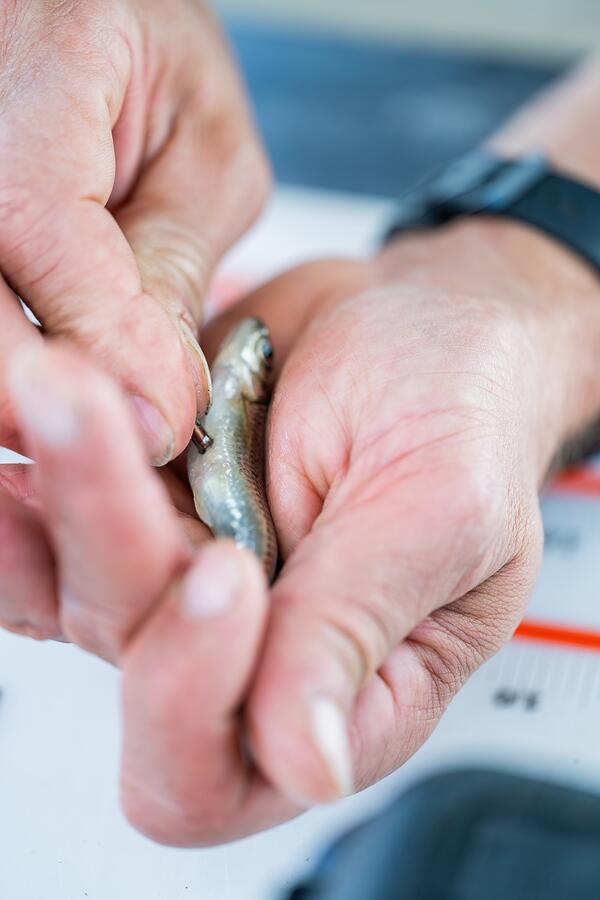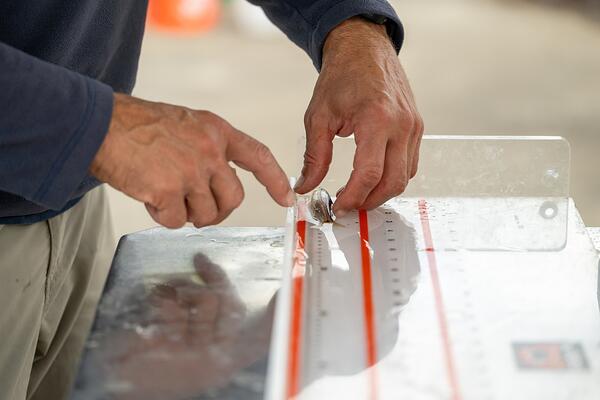Ted Castro-Santos of the S.O. Conte Research Laboratory implants a small pit tag into a juvenile American shad before release it into the canal at Turners Falls, MA.
Theodore Castro-Santos
Research Ecologist at the Eastern Ecological Science Center's S.O. Conte Research Laboratory in Turners Falls, MA
Human activities have caused extensive fragmentation of riverine corridors. Dams, culverts, and other barriers prevent migratory and riverine fishes from accessing key habitats. This is particularly problematic for diadromous fishes like Atlantic salmon and American shad that must transition between fresh- and saltwater habitats in order to complete their life cycles. Swimming performance and behavioral responses to hydraulic conditions (turbulence, velocity, etc.) are major interests, as is development of quantitative methods for identifying and characterizing barriers. This work has broad relevance, not only to stewardship and management of aquatic resources, but also to understanding fundamental aspects of the ecology and evolution of fishes. Some current projects include:
- Sprint-swimming performance of migratory and riverine species
- Effects of turbulence on swimming performance, biomechanics, and behavior
- Modeling fish passage through culverts
- Bioenergetics models of anadromous fish migration
Professional Experience
US Geological Survey (1995-present)
U.S. Fish and Wildlife Service (1992-1995)
Education and Certifications
PhD Organismic and Evolutionary Biology; University of Massachusetts Amherst (2002)
MS Wildlife Biology Washington State University (1991)
BA Colgate University (1987)
Affiliations and Memberships*
American Fisheries Society
Society for Integrative and Comparative Biology
Science and Products
Production, Behavior, and Survival of Juvenile Shad and River Herring
A generic web application to visualize and understand movements of tagged animals
Fish locomotion and biomechanics as limiting and optimizing factors in fish passage
Fish Biomechanics
Code and data from Castro-Santos et al.: Sprinting performance and behavior of shortnose sturgeon Code and data from Castro-Santos et al.: Sprinting performance and behavior of shortnose sturgeon
Data Release for Multimodal Invasive Carp Deterrent Study at Barkley Lock and Dam: Status Update through 2022 Data Release for Multimodal Invasive Carp Deterrent Study at Barkley Lock and Dam: Status Update through 2022
Data Release for Lock 19 Underwater Acoustic Deterrent System (UADS) Study: Interim Project Update Data Release for Lock 19 Underwater Acoustic Deterrent System (UADS) Study: Interim Project Update
Herring passage at Herring River Tidegates Herring passage at Herring River Tidegates
Ted Castro-Santos of the S.O. Conte Research Laboratory implants a small pit tag into a juvenile American shad before release it into the canal at Turners Falls, MA.
Ted-Castro Santos of the S.O. Conte Research Laboratory measures a juvenile American shad before tagging and releasing it into the Canal at Turners Falls, MA.
Ted-Castro Santos of the S.O. Conte Research Laboratory measures a juvenile American shad before tagging and releasing it into the Canal at Turners Falls, MA.
Ted Castro-Santos, EESC, and Katie Deters, PNNL, release tagged American Shad in the canal at the Conte Lab
Ted Castro-Santos, EESC, and Katie Deters, PNNL, release tagged American Shad in the canal at the Conte Lab
Two USGS scientist implant a radio tag in a sedated brown trout as a Deerfield River Watershed Chapter of Trout Unlimited volunteer looks on
Two USGS scientist implant a radio tag in a sedated brown trout as a Deerfield River Watershed Chapter of Trout Unlimited volunteer looks on
Spatial variation in landlocked Atlantic Salmon smolt survival associated with dam passage, avian predation, and stocking location Spatial variation in landlocked Atlantic Salmon smolt survival associated with dam passage, avian predation, and stocking location
Designing sortable guilds for multispecies selective fish passage Designing sortable guilds for multispecies selective fish passage
Sprinting performance and behavior of adult shortnose sturgeon (Acipenser brevirostrum) Sprinting performance and behavior of adult shortnose sturgeon (Acipenser brevirostrum)
Tagger effects in aquatic telemetry: Short-term and delayed impacts of surgery in Atlantic salmon smolts Tagger effects in aquatic telemetry: Short-term and delayed impacts of surgery in Atlantic salmon smolts
FishPass sortable attribute database: Phenological, morphological, physiological, and behavioural characteristics related to passage and movement of Laurentian Great Lakes fishes FishPass sortable attribute database: Phenological, morphological, physiological, and behavioural characteristics related to passage and movement of Laurentian Great Lakes fishes
FishPass baseline assessment of fish community assemblage and migratory patterns in in the Boardman River, Traverse City, Michigan, USA FishPass baseline assessment of fish community assemblage and migratory patterns in in the Boardman River, Traverse City, Michigan, USA
Multimodal invasive carp deterrent study at Barkley Lock and Dam—Status update through 2022 Multimodal invasive carp deterrent study at Barkley Lock and Dam—Status update through 2022
Lock 19 underwater acoustic deterrent system study—Interim project update, through 2022 Lock 19 underwater acoustic deterrent system study—Interim project update, through 2022
Using recovered radio transmitters to estimate positioning error and a generalized Monte Carlo simulation to incorporate error into animal telemetry analysis Using recovered radio transmitters to estimate positioning error and a generalized Monte Carlo simulation to incorporate error into animal telemetry analysis
Survival, healing, and swim performance of juvenile migratory sea lamprey (Petromyzon marinus) implanted with a new acoustic microtransmitter designed for small eel-like fishes Survival, healing, and swim performance of juvenile migratory sea lamprey (Petromyzon marinus) implanted with a new acoustic microtransmitter designed for small eel-like fishes
Environmental factors influencing detection efficiency of an acoustic telemetry array and consequences for data interpretation Environmental factors influencing detection efficiency of an acoustic telemetry array and consequences for data interpretation
Tracking anadromous fish over successive freshwater migrations reveals the influence of tagging effect, previous success and abiotic factors on upstream passage over barriers Tracking anadromous fish over successive freshwater migrations reveals the influence of tagging effect, previous success and abiotic factors on upstream passage over barriers
Science and Products
Production, Behavior, and Survival of Juvenile Shad and River Herring
A generic web application to visualize and understand movements of tagged animals
Fish locomotion and biomechanics as limiting and optimizing factors in fish passage
Fish Biomechanics
Code and data from Castro-Santos et al.: Sprinting performance and behavior of shortnose sturgeon Code and data from Castro-Santos et al.: Sprinting performance and behavior of shortnose sturgeon
Data Release for Multimodal Invasive Carp Deterrent Study at Barkley Lock and Dam: Status Update through 2022 Data Release for Multimodal Invasive Carp Deterrent Study at Barkley Lock and Dam: Status Update through 2022
Data Release for Lock 19 Underwater Acoustic Deterrent System (UADS) Study: Interim Project Update Data Release for Lock 19 Underwater Acoustic Deterrent System (UADS) Study: Interim Project Update
Herring passage at Herring River Tidegates Herring passage at Herring River Tidegates
Ted Castro-Santos of the S.O. Conte Research Laboratory implants a small pit tag into a juvenile American shad before release it into the canal at Turners Falls, MA.
Ted Castro-Santos of the S.O. Conte Research Laboratory implants a small pit tag into a juvenile American shad before release it into the canal at Turners Falls, MA.
Ted-Castro Santos of the S.O. Conte Research Laboratory measures a juvenile American shad before tagging and releasing it into the Canal at Turners Falls, MA.
Ted-Castro Santos of the S.O. Conte Research Laboratory measures a juvenile American shad before tagging and releasing it into the Canal at Turners Falls, MA.
Ted Castro-Santos, EESC, and Katie Deters, PNNL, release tagged American Shad in the canal at the Conte Lab
Ted Castro-Santos, EESC, and Katie Deters, PNNL, release tagged American Shad in the canal at the Conte Lab
Two USGS scientist implant a radio tag in a sedated brown trout as a Deerfield River Watershed Chapter of Trout Unlimited volunteer looks on
Two USGS scientist implant a radio tag in a sedated brown trout as a Deerfield River Watershed Chapter of Trout Unlimited volunteer looks on
Spatial variation in landlocked Atlantic Salmon smolt survival associated with dam passage, avian predation, and stocking location Spatial variation in landlocked Atlantic Salmon smolt survival associated with dam passage, avian predation, and stocking location
Designing sortable guilds for multispecies selective fish passage Designing sortable guilds for multispecies selective fish passage
Sprinting performance and behavior of adult shortnose sturgeon (Acipenser brevirostrum) Sprinting performance and behavior of adult shortnose sturgeon (Acipenser brevirostrum)
Tagger effects in aquatic telemetry: Short-term and delayed impacts of surgery in Atlantic salmon smolts Tagger effects in aquatic telemetry: Short-term and delayed impacts of surgery in Atlantic salmon smolts
FishPass sortable attribute database: Phenological, morphological, physiological, and behavioural characteristics related to passage and movement of Laurentian Great Lakes fishes FishPass sortable attribute database: Phenological, morphological, physiological, and behavioural characteristics related to passage and movement of Laurentian Great Lakes fishes
FishPass baseline assessment of fish community assemblage and migratory patterns in in the Boardman River, Traverse City, Michigan, USA FishPass baseline assessment of fish community assemblage and migratory patterns in in the Boardman River, Traverse City, Michigan, USA
Multimodal invasive carp deterrent study at Barkley Lock and Dam—Status update through 2022 Multimodal invasive carp deterrent study at Barkley Lock and Dam—Status update through 2022
Lock 19 underwater acoustic deterrent system study—Interim project update, through 2022 Lock 19 underwater acoustic deterrent system study—Interim project update, through 2022
Using recovered radio transmitters to estimate positioning error and a generalized Monte Carlo simulation to incorporate error into animal telemetry analysis Using recovered radio transmitters to estimate positioning error and a generalized Monte Carlo simulation to incorporate error into animal telemetry analysis
Survival, healing, and swim performance of juvenile migratory sea lamprey (Petromyzon marinus) implanted with a new acoustic microtransmitter designed for small eel-like fishes Survival, healing, and swim performance of juvenile migratory sea lamprey (Petromyzon marinus) implanted with a new acoustic microtransmitter designed for small eel-like fishes
Environmental factors influencing detection efficiency of an acoustic telemetry array and consequences for data interpretation Environmental factors influencing detection efficiency of an acoustic telemetry array and consequences for data interpretation
Tracking anadromous fish over successive freshwater migrations reveals the influence of tagging effect, previous success and abiotic factors on upstream passage over barriers Tracking anadromous fish over successive freshwater migrations reveals the influence of tagging effect, previous success and abiotic factors on upstream passage over barriers
*Disclaimer: Listing outside positions with professional scientific organizations on this Staff Profile are for informational purposes only and do not constitute an endorsement of those professional scientific organizations or their activities by the USGS, Department of the Interior, or U.S. Government









